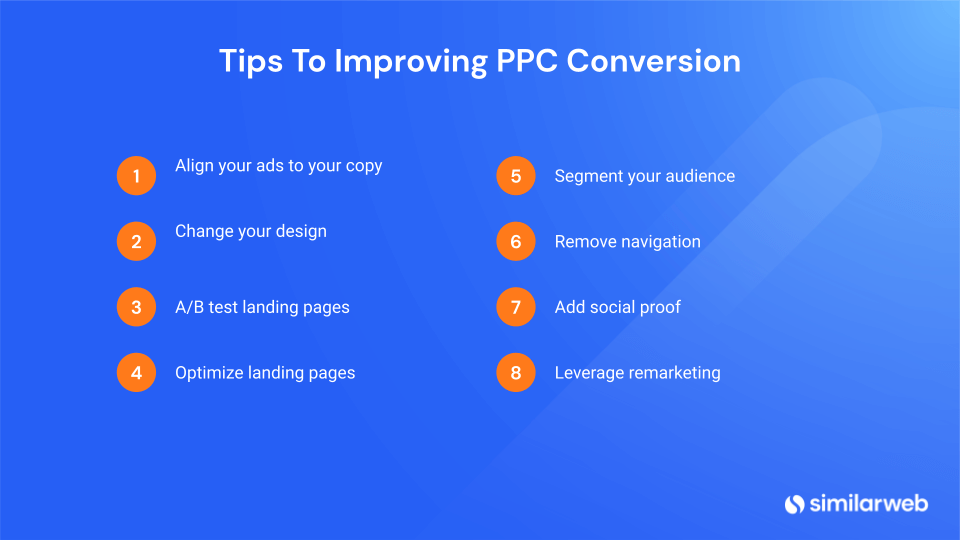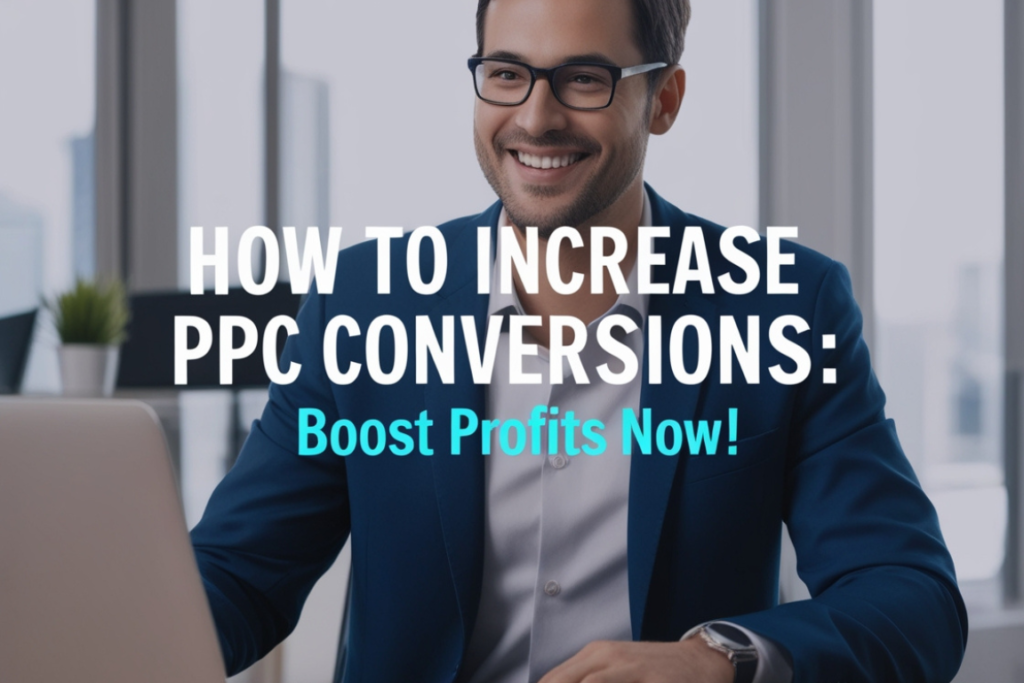To increase PPC conversions, optimize ad copy and landing pages for relevance and user intent. Use precise targeting and compelling CTAs.
Pay-per-click (PPC) advertising can be a highly effective way to drive traffic and increase conversions. Success hinges on creating compelling ads, targeting the right audience, and ensuring seamless user experiences. Optimize your ad copy to match search intent and refine your landing pages to keep visitors engaged.
Precision in targeting helps you reach the most relevant audience, maximizing your ROI. Use strong calls-to-action (CTAs) to guide users towards conversion. Analyzing and adjusting campaigns regularly can further enhance performance, ensuring that your ads remain effective and competitive. Focus on these strategies to boost your PPC conversions.
The Importance of PPC Conversions
Pay-per-click (PPC) conversions are crucial for any online advertising strategy. They help measure the effectiveness of your ad campaigns. High conversion rates indicate successful ad performance. This means your audience finds your ads relevant and engaging. Low conversion rates suggest a need for optimization. Effective PPC conversions lead to more revenue and better customer engagement.
Linking Conversions To Revenue Growth
PPC conversions directly impact your revenue growth. Each conversion represents a potential sale or lead. More conversions mean higher chances of revenue. For instance, if you spend $100 on ads and get 10 conversions, each conversion costs $10. If each conversion generates $50 in revenue, your profit is $40 per conversion.
Understanding this link helps in budget allocation. You can focus more on high-converting keywords and ad groups. This ensures maximum return on investment (ROI).
| Ad Spend | Conversions | Cost per Conversion | Revenue per Conversion | Profit per Conversion |
|---|---|---|---|---|
| $100 | 10 | $10 | $50 | $40 |
PPC’s Role In Digital Marketing Strategy
PPC is an essential part of a digital marketing strategy. It offers quick results and measurable outcomes. PPC helps in targeting specific demographics. You can reach your ideal customers easily. This precision targeting improves conversion rates.
Integrating PPC with SEO can enhance your online presence. While SEO builds organic traffic, PPC provides instant visibility. Together, they create a robust digital marketing strategy.
- Quick results
- Measurable outcomes
- Precision targeting
- Enhanced online presence
Effective PPC campaigns require continuous monitoring and optimization. Use analytics to track performance. Adjust bids, keywords, and ad copy for better results. This ongoing process ensures sustained growth and higher conversions.
Setting Clear Conversion Goals
Setting clear conversion goals is crucial for maximizing your PPC campaign success. Without specific goals, you can’t measure the effectiveness of your efforts. Clear goals provide a roadmap for your strategy and help identify areas for improvement.
Identifying Desired Actions
First, identify the actions you want users to take. These actions should align with your marketing objectives. Common desired actions include:
- Completing a purchase
- Filling out a contact form
- Signing up for a newsletter
- Downloading a whitepaper
Each action should be measurable. Use tracking tools like Google Analytics to monitor these actions. This way, you can see which actions convert best and adjust your strategy accordingly.
Aligning Goals with Business Objectives
It’s essential to align your conversion goals with your business objectives. This ensures that your PPC efforts contribute to your overall growth. Here are steps to achieve this:
- Review your business objectives.
- Define how PPC can support these objectives.
- Set specific, measurable goals for your PPC campaigns.
For example, if your business objective is to increase revenue, set a goal to boost sales conversions. This alignment helps in creating focused and effective campaigns.
Use the table below to map your PPC goals to business objectives:
| Business Objective | PPC Goal |
|---|---|
| Increase Revenue | Boost Sales Conversions |
| Expand Customer Base | Increase Newsletter Signups |
| Enhance Brand Awareness | Improve Ad Click-Through Rates |
By setting clear goals, you create a path for success. This clarity helps in measuring and optimizing your PPC campaigns effectively.

Credit: www.mayple.com
Keyword Optimization Strategies
Boosting your PPC conversions requires a strategic approach. One critical aspect is Keyword Optimization Strategies. By honing in on the right keywords, you can attract high-intent users ready to convert. Below are essential strategies to help you optimize your keywords effectively.
Researching High-intent Keywords
High-intent keywords are crucial for successful PPC campaigns. These keywords indicate that users are ready to take action. Use tools like Google Keyword Planner or SEMrush to find these valuable keywords.
- Identify Commercial Keywords: Keywords like “buy,” “discount,” and “deal” show purchase intent.
- Analyze Competitors: Check the keywords your competitors target. This offers insight into effective terms.
- Use Customer Feedback: Analyze customer reviews and feedback for keyword ideas.
Balancing Broad And Long-tail Keywords
Balancing broad and long-tail keywords can enhance your PPC performance. Broad keywords attract a wide audience, while long-tail keywords target specific user needs.
| Keyword Type | Benefits | Examples |
|---|---|---|
| Broad Keywords | Reach a large audience | shoes, laptops, travel |
| Long-Tail Keywords | Higher conversion rates | buy running shoes online, best laptops for gaming |
Use a mix of both to cover all your bases. Start with broad keywords to gather data. Then refine your strategy by focusing on high-converting long-tail keywords.
Crafting Compelling Ad Copy
Crafting compelling ad copy is essential for increasing PPC conversions. Your ad must grab attention and provide value. Clear, concise, and engaging text can drive more clicks and conversions. Focus on addressing user needs and guiding them towards action.
Writing To Address Pain Points
Identify your audience’s pain points. Understand their problems and offer solutions. Use empathy in your ad copy. Show you understand their struggles. Provide a clear benefit that addresses their issue.
- Highlight the problem they face.
- Show how your product solves it.
- Use emotional triggers to connect.
Example: If users struggle with slow internet, your ad could say, “Tired of slow internet? Get blazing-fast speeds now!”
Using Call-to-actions Effectively
A strong call-to-action (CTA) is crucial. It tells users what to do next. Make your CTA clear and direct. Use action words that create urgency.
| Weak CTA | Strong CTA |
|---|---|
| Click Here | Get Started Now |
| Learn More | Discover Your Solution Today |
Place your CTA where it’s easily visible. Test different CTAs to see which performs best. Keep them short and impactful.
Example: Instead of “Submit”, use “Get Your Free Quote Now”.
Improving Landing Page Experiences
Improving landing page experiences is crucial for increasing PPC conversions. A well-optimized landing page can make or break your PPC campaign. Let’s dive into some essential strategies to enhance your landing page.
Ensuring Message Match
Message match means that your ad copy and landing page content align perfectly. This ensures a seamless user experience. Here’s how to achieve it:
- Use the same keywords in your ad and landing page.
- Maintain consistent visuals and colors.
- Ensure the headline on the landing page matches the ad copy.
- Provide the promised offer or information immediately.

Credit: www.similarweb.com
Optimizing For Speed And Usability
Speed and usability are paramount for a great user experience. A slow or confusing landing page can deter users. Follow these tips to enhance speed and usability:
- Minimize image sizes without compromising quality.
- Enable browser caching and compression.
- Use a Content Delivery Network (CDN).
- Ensure your landing page is mobile-friendly.
To ensure usability, focus on these elements:
- Clear and concise call-to-action (CTA) buttons.
- Simple and easy-to-navigate layout.
- Readable fonts and contrasting colors.
- Minimize form fields to reduce friction.
By implementing these strategies, you can significantly improve your landing page experiences and boost PPC conversions.
Utilizing Ad Extensions Wisely
Ad extensions can significantly boost your PPC conversions. They provide extra information and additional ways for users to interact with your ad. Wise use of ad extensions enhances visibility, improves click-through rates (CTR), and increases overall conversions.
Choosing Relevant Extensions
Choosing the right ad extensions is crucial. Different extensions serve different purposes. Here are some common types:
- Sitelink Extensions: Direct users to specific pages on your site.
- Call Extensions: Allow users to call your business directly from the ad.
- Location Extensions: Show your business address and map location.
- Callout Extensions: Highlight key features or offers.
- Structured Snippet Extensions: Provide additional details about your products or services.
Choose extensions that align with your business goals. For example, use call extensions if you want more phone inquiries.
Tracking Extension Performance
Tracking the performance of your ad extensions is essential. Use these methods to monitor and optimize:
- Google Ads Reports: Check the performance of each extension in your Google Ads account.
- Conversion Tracking: Set up conversion tracking to see which extensions drive the most conversions.
- A/B Testing: Experiment with different extensions to find the most effective ones.
Analyze the data regularly. Remove underperforming extensions and focus on the ones driving results.
A/b Testing For Better Results
A/B testing is essential for improving PPC conversions. It involves comparing two versions of a web page or ad to determine which performs better. By testing ad variations, you can optimize your campaigns and achieve higher conversions.
Testing Ad Variations
Start by creating different ad versions. Change one element at a time. This could be the headline, image, or call-to-action. Keep other elements constant.
- Headline: Test different headlines to see which grabs attention.
- Image: Use various images to find the most engaging one.
- Call-to-action: Experiment with different phrases to boost clicks.
Run your ads simultaneously. Ensure you have enough data for accurate results. Use an equal budget for each variation.
Analyzing And Interpreting Test Data
After gathering data, analyze the results. Look at key metrics such as click-through rate (CTR) and conversion rate.
| Metric | Variation A | Variation B |
|---|---|---|
| CTR | 5% | 7% |
| Conversion Rate | 3% | 4.5% |
Identify the winning variation. Implement changes based on these findings. Continue testing new elements for continuous improvement.
A/B testing helps you understand what resonates with your audience. It guides your decisions, leading to better PPC performance.
Leveraging Retargeting Tactics
Retargeting tactics can significantly boost your PPC conversions. By targeting users who have already shown interest, you increase the likelihood of conversion. Below, we’ll explore effective strategies for leveraging retargeting tactics.
Understanding Audience Segmentation
Audience segmentation is crucial for successful retargeting. It involves dividing your audience into specific groups based on behavior or demographics.
Here are some common segments to consider:
- Website Visitors: Users who have visited your site but did not convert.
- Cart Abandoners: Users who added items to their cart but did not complete the purchase.
- Previous Customers: Users who have already made a purchase and may buy again.
Creating Custom Retargeting Campaigns
Creating custom retargeting campaigns tailored to each segment can yield better results. Different messages and offers work for different groups.
Here are steps to create effective campaigns:
- Identify your goals: Determine what you want to achieve with each campaign.
- Choose the right platforms: Select platforms where your audience is active, like Google Ads or Facebook.
- Craft compelling messages: Create messages that resonate with each segment.
- Offer incentives: Provide discounts or special offers to encourage conversions.
- Monitor and adjust: Continuously track performance and make necessary adjustments.
Managing PPC Budgets Effectively
Managing your PPC budgets is crucial for maximizing your return on investment (ROI). Effective management ensures your money is spent wisely. This leads to higher conversion rates and better overall performance. Below, we explore two key strategies for managing your PPC budgets: Allocating Spend Across Campaigns and Adjusting Bids for Maximum ROI.
Allocating Spend Across Campaigns
Distributing your budget across various campaigns is vital. Not all campaigns yield the same results. Some might perform better than others. Use data to allocate funds smartly.
| Campaign Type | Budget Allocation (%) |
|---|---|
| Brand Awareness | 30% |
| Lead Generation | 50% |
| Retention | 20% |
Monitor performance regularly. Adjust allocations based on results. If one campaign performs better, consider increasing its budget. This ensures your money is used where it brings the best returns.

Credit: www.optmyzr.com
Adjusting Bids For Maximum Roi
Adjusting bids is another way to optimize your PPC budget. Higher bids can place your ads in better positions. This leads to higher visibility and more clicks.
- Identify high-performing keywords: Spend more on these keywords.
- Reduce bids on low-performing keywords: Save budget for more effective keywords.
- Test different bid amounts: Find the sweet spot for each keyword.
Use tools like Google Ads to track performance. Adjust bids based on data. This ensures you get the most out of your budget.
Monitoring And Adjusting Campaigns
To increase PPC conversions, monitoring and adjusting campaigns is crucial. By regularly reviewing performance, you can optimize your ads and ensure higher returns. This process involves using analytics and making data-driven improvements.
Using Analytics For Informed Decisions
Analytics tools provide valuable insights into your campaign performance. These tools help identify which ads work best and which need improvement. Key metrics to focus on include:
- Click-Through Rate (CTR): Measures the percentage of clicks per impression.
- Conversion Rate: Indicates the percentage of clicks that result in conversions.
- Cost Per Click (CPC): Shows the average cost of each click.
- Return on Ad Spend (ROAS): Evaluates the revenue generated per dollar spent on ads.
By analyzing these metrics, you can make informed decisions. Adjust your campaigns based on actual performance data.
Making Data-driven Improvements
Data-driven improvements boost your campaign effectiveness. Here are key steps:
- Identify Underperforming Ads: Use analytics to spot ads with low CTR or conversions.
- Test Different Ad Variations: Create A/B tests to compare different headlines, descriptions, and images.
- Optimize Keywords: Focus on high-performing keywords and remove low-performing ones.
- Adjust Bidding Strategy: Increase bids for successful ads and reduce them for underperforming ones.
- Refine Target Audience: Use demographic and behavioral data to target the right audience.
By following these steps, you ensure your PPC campaigns are always optimized for the best performance. Continuously monitor and adjust your campaigns to keep improving your conversion rates.
Staying Updated with PPC Trends
Keeping up with the latest PPC trends can significantly boost your conversions. The digital marketing landscape changes rapidly. Staying current helps you leverage new opportunities and stay ahead of competitors. For this contact us.
Exploring Emerging Technologies
New technologies can enhance your PPC campaigns. Adopting them early gives you a competitive edge.
- Artificial Intelligence (AI): AI can optimize your ads and bid strategies.
- Machine Learning (ML): ML improves targeting by analyzing user behavior.
- Voice Search: Optimize for voice search to capture more leads.
AI and ML can automate repetitive tasks. They also provide insights that improve your campaign performance. Voice search is growing. Ensure your ads are voice search-friendly to reach a wider audience.
Adapting To Industry Changes
Industry changes can impact your PPC strategy. Adapting quickly ensures you stay effective.
- Policy Updates: Stay informed about platform policies to avoid penalties.
- Algorithm Changes: Adjust strategies based on new search algorithms.
- Consumer Behavior: Monitor shifts in behavior to refine targeting.
Policy updates from ad platforms can affect your campaigns. Regularly review these changes. Algorithm updates may impact your ad rankings. Adapt your strategies to maintain visibility. Consumer behavior evolves. Keep your targeting aligned with current trends.
Staying updated with PPC trends is crucial. It keeps your campaigns effective and competitive.
Conclusion: Maximizing Ppc Potential
To truly maximize your PPC potential, continuous improvement and strategic tweaks are essential. By understanding key insights and encouraging ongoing optimization, your PPC campaigns can reach new heights.
Recapping Key Takeaways
Let’s quickly revisit the most crucial points:
- Keyword Research: Focus on high-intent keywords that drive conversions.
- Ad Copy: Craft compelling and relevant ad copy to engage users.
- Landing Pages: Ensure your landing pages are optimized for conversions.
- A/B Testing: Regularly test different elements to identify what works best.
- Analytics: Use data to make informed decisions and refine strategies.
Encouraging Ongoing Optimization
Ongoing optimization is key to maintaining and increasing PPC conversions. Here are some steps to ensure continued success:
- Monitor Performance: Regularly review your PPC metrics and adjust as needed.
- Update Keywords: Continuously update your keyword list to stay relevant.
- Refine Ad Copy: Keep your ad copy fresh and aligned with user search intent.
- Improve Landing Pages: Make iterative changes to landing pages for better user experience.
- Stay Informed: Keep up with industry trends and best practices.
By following these steps, you can ensure that your PPC campaigns remain effective and continue to drive conversions.
Frequently Asked Questions
What Is Ppc Conversion?
PPC conversion occurs when a user clicks your ad and completes a desired action, like a purchase. It signifies successful ad engagement.
How Can I Improve Ppc Ad Relevance?
Improve ad relevance by targeting the right keywords, crafting compelling ad copy, and using engaging visuals. Regularly update your ads.
Why Is Landing Page Quality Important?
Landing page quality affects user experience and conversion rates. Ensure your landing page loads quickly, is mobile-friendly, and has clear CTAs.
How Do I Track Ppc Conversions?
Track PPC conversions using tools like Google Analytics or your ad platform’s conversion tracking. These tools provide detailed performance data.
Conclusion
Boosting PPC conversions requires strategy, analysis, and continuous improvement. Focus on targeting, ad copy, and landing page optimization. Monitor performance and adjust campaigns as needed. Implement these tips, and you’ll see better results. Remember, success in PPC is about consistent effort and refinement. Start optimizing today and watch your conversions grow.

